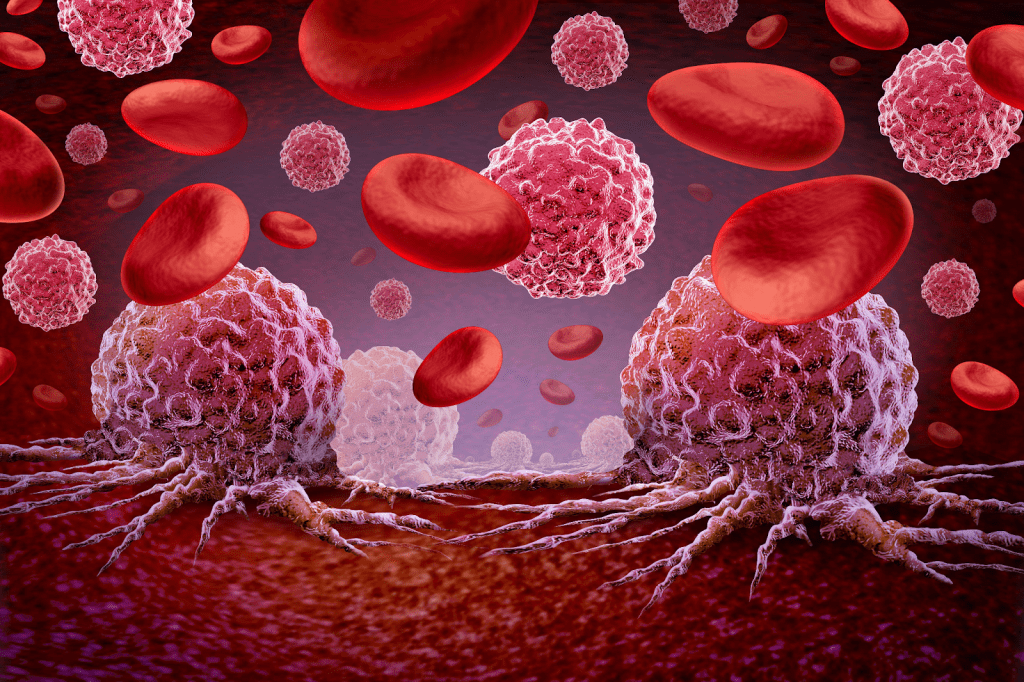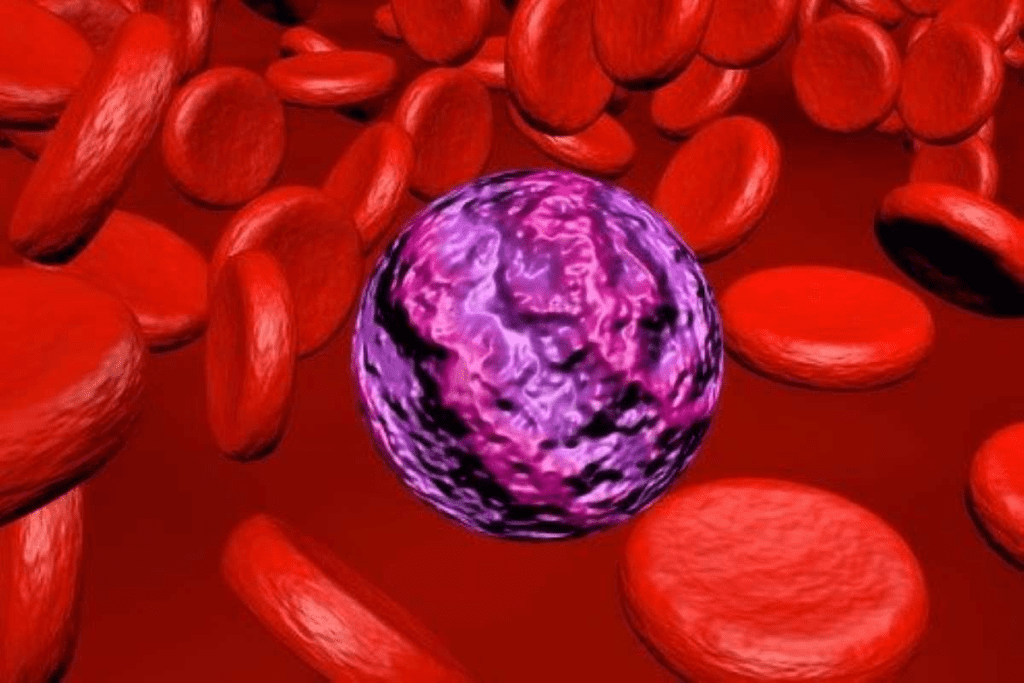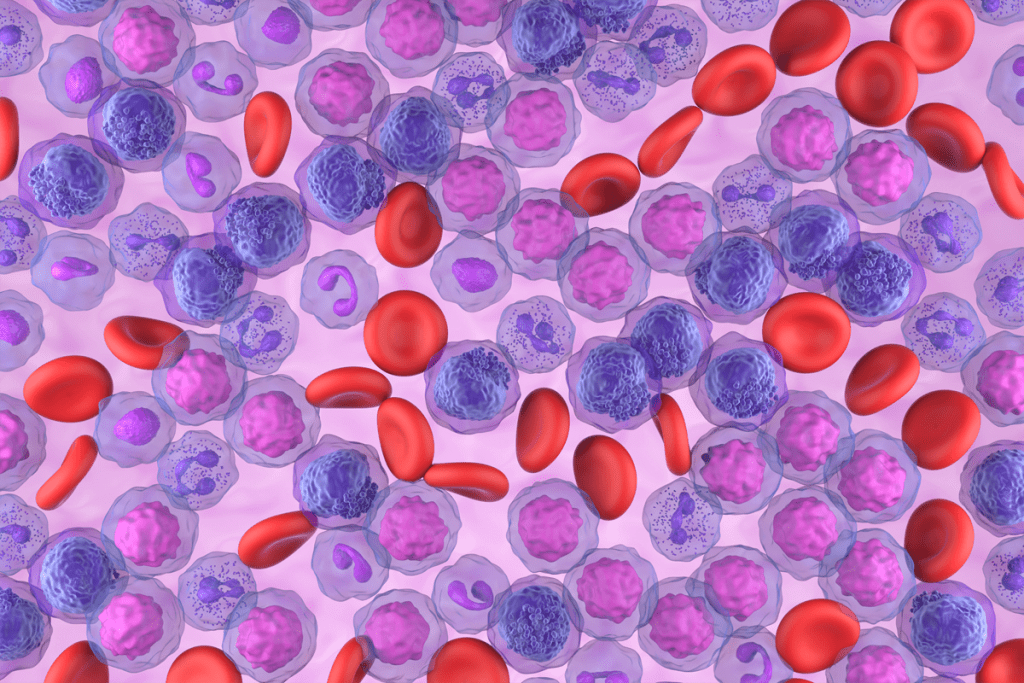Last Updated on November 13, 2025 by
Diagnosing early signs of leukemia in blood work starts with a simple test: a blood test. We use blood tests, like the complete blood count (CBC), to find signs of leukemia. These tests are key in spotting problems early.

The CBC test looks at different parts of the blood. It checks white blood cells, red blood cells, and platelets. If these levels are off, it might mean leukemia. Knowing how leukemia is found is key to quick treatment.
Learning about leukemia is key to early detection and treatment. This can greatly improve patient outcomes. Leukemia is a cancer that affects the blood and bone marrow. It’s caused by abnormal white blood cells growing out of control.
This disrupts the normal blood cell production. It leads to various health issues.

In leukemia, the bone marrow makes abnormal white blood cells. These cells don’t work right. They take over the bone marrow, making it hard for the body to fight off infections.
The disease can progress differently for everyone. Some people get worse fast, while others may not show symptoms for a while.
Leukemia is divided into two main types: acute and chronic. Acute leukemia is fast-moving and needs quick treatment. Chronic leukemia grows more slowly. Knowing the type of leukemia is important for the right treatment.
Blood tests are critical for diagnosing and tracking leukemia. They help doctors check blood cell levels and spot any oddities. A Complete Blood Count (CBC) is often the first test for leukemia. It gives a detailed look at blood cell counts.
New tech, like artificial intelligence (AI) and machine learning, has made diagnosing leukemia better. These tools can spot leukemia with 89“98% accuracy. Using these technologies helps find leukemia early and accurately. This leads to better treatment plans.
The Complete Blood Count (CBC) test is key in finding leukemia. LivHospital uses the latest science and international standards for blood tests. A CBC checks white, red blood cells, and platelets to see if they’re healthy.

A CBC test looks closely at the blood’s cells. It checks:
Knowing the difference between normal and abnormal blood values is key to finding leukemia. Normal values are specific, but they can change slightly between labs. If your values are off, it could mean leukemia or another health problem.
CBC tests are a main way to find leukemia because they give a full picture of your blood cells. They’re not the only test needed, but they can lead to more tests if something looks off. At Liv Hospital, we use advanced CBC tests to spot leukemia early, so we can start treatment right away.
Understanding CBC tests and what abnormal values mean is important for doctors. Regular CBC tests can help catch changes in your blood cells early. This helps in finding and treating leukemia sooner.
Blood tests are key in spotting early sign of leukemia in blood work. They show changes in blood cell production. Leukemia, a blood cancer, impacts how blood cells are made.
An abnormal white blood cell count is an early leukemia sign. These cells fight infections. Leukemia makes too many immature white blood cells, called blasts, which push out normal cells.
Abnormal white blood cell counts hint at leukemia. We look for big changes from normal levels. This could mean leukemia cells are present.
Leukemia can also mess with red blood cell production, causing anemia. Anemia leads to tiredness, weakness, and shortness of breath. It’s due to low hemoglobin levels.
Red blood cell irregularities show up early in leukemia. This includes fewer red blood cells or trouble carrying oxygen.
Platelets help blood clot, and leukemia can affect their count. Low platelet count, or thrombocytopenia, causes bruising and bleeding. High counts, or thrombocytosis, can also be a sign.
Both low and high platelet counts suggest leukemia and need more tests.
Leukemia can also change blood chemistry. This includes higher levels of certain enzymes and proteins. Blood tests can spot these changes.
Blood chemistry tests show signs of leukemia. For example, high lactate dehydrogenase (LDH) levels are a clue.
Blood tests suggest leukemia, but more tests confirm the type. Knowing these signs early is key to quick medical help.
Diagnosing leukemia involves several key steps, from blood screening to confirmatory tests. Knowing what to expect can help a lot. It makes the process less scary.
The first step is a Complete Blood Count (CBC) test. This test checks the blood’s components, like white and red blood cells, and platelets. If these counts are off, it might mean leukemia.
A CBC is a common test that gives us important blood information. Our doctors look at the results to see if they show leukemia signs.
If the CBC shows odd blood cell counts, doctors might think of leukemia. Then, we dig deeper to find out why. We look at the patient’s health history, symptoms, and overall condition.
It’s key to know that odd blood counts don’t always mean leukemia. But, they do mean we need to do more tests to check.
To really confirm leukemia, we often need more tests than just blood work. A bone marrow biopsy is one of them. It checks for cancer cells in the bone marrow. This test tells us the leukemia type and how serious it is.
Known Clinic says a bone marrow biopsy is key to diagnosing leukemia. We use this info to create a treatment plan that fits the patient’s needs.
Knowing how we diagnose leukemia can help ease worries. We’re here to support our patients every step of the way. We want to make sure they get the care and support they need.
AI and machine learning are changing how we find leukemia. They make diagnoses faster and more accurately. This helps doctors catch leukemia early, which is good for patients.
Research shows AI and machine learning can spot leukemia with 89“98% accuracy. This is key to planning the right treatment. Thanks to these tools, doctors can now make more accurate tests for leukemia cancer diagnoses.
AI looks at cell shape and genetic markers to sort leukemic cells. This helps doctors know what type of leukemia it is. They can then choose the best treatment.
AI helps doctors quickly spot leukemic cells. This makes diagnosis faster and more reliable. Quick action is key in treating leukemia.
Consistency in diagnosis is another big plus. AI systems are very reliable, making results more consistent.
Hospitals are starting to use AI and machine learning. This is leading to better care for leukemia patients. It’s a big step forward.
As we keep using AI and machine learning, we’ll see even better results. The future of finding and treating leukemia looks bright.
Blood tests are key in finding leukemia, but they have their limits. Modern blood tests have improved, but they face challenges. Healthcare providers must deal with these issues.
Sometimes, blood tests can’t find leukemia. This happens when cancer cells aren’t in the blood at test time. Then, leukemia might only be found when symptoms get worse or in later tests.
Early-stage leukemia is hard to spot with blood tests alone. This is because the abnormal cells might not change blood cell counts much.
Blood tests for leukemia can give false results. A false positive says leukemia is there when it’s not. This causes worry and more tests. On the other hand, a false negative says it’s not there when it is. This can be very misleading.
Because of blood test limits, more tests are needed to confirm leukemia. These include bone marrow biopsies, imaging, and genetic tests. They help figure out the leukemia type and how serious it is.
At LivHospital, we take a detailed approach to leukemia diagnosis. Our team uses blood tests, bone marrow exams, and advanced imaging. This ensures we get the diagnosis right.
By using these tools together, we can give a precise diagnosis. Then, we create a treatment plan that fits the patient’s needs.
Understanding leukemia through blood tests is complex. It involves looking at different blood parts and their changes. We’ve seen how a Complete Blood Count (CBC) test is the first step, and how AI and machine learning are changing how we detect leukemia.
The future of blood testing for leukemia is bright. Advances in AI and machine learning are making diagnoses more accurate and quicker. This means doctors can start treatments sooner. At LivHospital, we aim to give top-notch care to all patients, including those with leukemia symptoms in women.
Blood tests are key, but they’re not the only tool. A full diagnosis also includes more tests and checks. By using the latest tech and expert care, we can help patients better and support them every step of the way.
Doctors use blood tests, like the complete blood count (CBC) test, to find leukemia. The CBC test checks the blood for white, red cells, and platelets. If these levels are off, it might mean leukemia.
Leukemia is a blood cancer. It happens when the bone marrow makes bad white blood cells. This can cause health issues.
Early leukemia signs include changes in blood cell counts. These changes can show up in blood tests, like the CBC.
Blood tests, like the CBC, are very good at finding leukemia. But, more tests might be needed to be sure. New AI and machine learning techniques have made these tests even better, with accuracy rates of 89-98%.
Leukemia stages depend on the type and the person’s health. Doctors use these stages to understand how serious the disease is and if symptoms are present.
Yes, a blood test, like the CBC, can spot leukemia early. It looks for abnormal blood cell levels.
AI and machine learning are changing how we find leukemia. They help doctors spot cancer cells and check blood and bone marrow samples better.
Yes, blood tests might not always be right. They can sometimes say there’s cancer when there isn’t, or miss it. More tests might be needed to be sure.
LivHospital uses the newest tech, like AI, for accurate leukemia diagnosis and treatment. Our team works with patients to get the right diagnosis and treatment.
The CBC test is key to finding leukemia. It checks the blood for abnormal levels of white, red cells, and platelets. These changes can mean leukemia.
Subscribe to our e-newsletter to stay informed about the latest innovations in the world of health and exclusive offers!